Electrical systems
Electrical systems around the world differ in voltage and, less critically, frequency. Plugs and sockets also vary and it might be physically impossible to insert the plug on your appliance into sockets at another place. There are some steps you can take to ensure that your electrical appliances can be used, and used safely, at your destination.
Understand
| “ | Electricity is really just organized lightning. | ” |
—George Carlin | ||
Voltage and frequency
| WARNING: It is very important to only connect a device to voltage in the range it is designed for. In all cases using an input voltage outside the design specification is an exceedingly bad idea.
In particular, connecting a device that is designed for 110 V to a 230 V supply can be very dangerous; there is severe risk of damage to the device, and it may catch fire or even explode! For a simple resistive load doubling the input voltage quadruples the power and heat, and this is a reasonable first approximation for any load. Connecting a higher voltage (220–240 V) device to a low voltage supply (110 V) is not completely risk free, although certainly much less dangerous than the other way round. Never assume the voltage is correct just because the plug fits. | |

Yellow shades: 100–127 V, 50 Hz
Red shades: 100–127 V, 60 Hz
Blue shades: 220–240 V, 50 Hz
Green shades: 220–240 V, 60 Hz
Start by taking a look at the back of the device or charger you want to use and find the numbers for "input". If the input reads "100–240 V, 50/60 Hz", it will work anywhere in the world with the right plugs. It is quite common for devices designed for travel use, such as cell phone chargers or laptop power supplies, to cover this range of input possibilities, but it needs to be checked for every device.
If you've got voltage and frequency covered, you can skip to the plugs and adapters section. If not, keep reading here.
Dealing with electricity differences can be daunting, but it actually isn't too hard. There are only two main types of electric systems used around the world, with varying physical connections:
- 100–127 volt, at 60 Hz frequency (in general: North America including Central America, Japan)
- 220–240 volt, at 50 Hz frequency (in general: the rest of the world, with some exceptions)
Occasionally, you will find 100–127 volts at 50 Hz, such as in Tokyo and some Caribbean islands. On the other hand, there's 220–240 volts at 60 Hz, such as in South Korea, Peru, some states of Brazil and Guyana. A few other countries using 60 Hz are internally divided, with 100–127 volts in some locations, and 220–240 volts in others, such as in Brazil, the Philippines, and Saudi Arabia. Be extra careful each time you travel to a new destination within these countries, and ask about the voltage.
The voltage and frequency aboard ships varies depending on where the ship was built and where it is or was supposed to be used. Aircraft in-seat power universally use 115 volt 60 Hz.
If the voltage and frequency for your device is the same as where you are travelling, then you need to worry only about the physical plug. Most devices have a voltage tolerance of around 10 percent, so there is no point in worrying about the difference between 220 and 240 volts or between 110 and 120 volts.
If the voltage provided by the local supply is not within the range accepted by your device, then you will need a transformer or converter to convert the voltage. Most travel accessory sources offer them and come with several plug adapters to solve all but the most exotic needs.
In addition to these, you might be able to use the 12 or 24 volt DC systems of cars and boats or the 5 volt DC of the USB port on computers to charge small devices like cameras and mobile phones.
Plugs and adapters
A device that lets you insert a plug into a different socket is an adapter: these are small and cheap. For example, between Britain and Germany, you need only an adapter. You stick your British plug in the adapter, which connects the rectangular phase/live and neutral prongs to the round German ones and puts the ground ("Earth") where the German outlet expects it. Then, you're good to go.
Unfortunately, there are many different plugs in the world. The five most widespread standards are the following:
| Image | Name | Description | Regions of use | Voltage | Notes |
|---|---|---|---|---|---|
 | Type A/B "American" | Two vertical pins, round ground pin | North and Central America, Thailand, Japan, Taiwan | usually 100–127 V
Thailand and Philippines 220–240 V |
|
 | Type C/E "French" | Two round pins, inverted round ground | France, Belgium, Poland, Czech Republic, Slovakia | 220–240 V | Many plugs and adaptors are designed to fit both type E and F sockets |
 | Type C/F "Schuko" | Two round pins, side contacts for ground | most of Europe, Russia, South Korea | 220–240 V | |
 | Type G "British" | Three rectangular pins | British Isles, Malaysia, Singapore, Hong Kong
(occasionally India & Uzbekistan) |
220–240 V | |
 | Type I "Australian" | Two slanted pins, vertical ground pin | Australia, New Zealand, Pacific Islands, China, Argentina | 220–240 V | The Chinese plug is upside down and has slightly longer pins than the AU/NZ plug. |

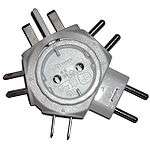
If your device has one of these plugs and you can adapt it to the others, you have 95% of the world covered, for equipment that can handle the local voltage and frequency. The main exceptions are India and South Africa. Adapters between Type A and Type C and from C to G are tiny and cheap; converting Type A into G or Type G into anything else, on the other hand, often needs a bulkier model.
For hobbyists: if you can't find an adapter, and you're staying for a longer time, just buy a separate plug at your destination, remove the existing plug, and attach the new one. Unlike adapters, plugs are always available, and they're generally cheaper too. Caution: try this only if you know what you're doing! Fire and/or electrocution are possible if you are inexperienced. Also note the wiring colours and orientation of phase/live and neutral pins vary between countries as well; in some regions two phases may be connected instead of one to neutral.
There's one more complication to consider: any two-pin socket is ungrounded, but all three-pin plugs are grounded ("Earthed"). Trying to get grounding to work makes life more difficult, as any of sockets C, E, F, H, J, K, N and some versions of D and L will happily accept the ungrounded plug C but will not work with any grounded variant other than their own. Do not use an adapter to turn a three-pin into a two-pin: this will disable grounding, potentially leaving you vulnerable to electrocution and other electrical nastiness.
A last word of warning: many developing countries use multi-plug sockets that accept (say) both Type A and Type C. Don't assume the voltage is correct just because the plug fits, since a Thai Type A+C socket still carries 220 V and may destroy American (110 V) Type A devices.
Transformer or converter?
|
Technical details The difference between a transformer and converter is the way that they deal with the wave-form of the electricity. Converters simply chop the wave in half. This is relatively simple and can be done in a small amount of space, so converters are comparatively light-weight and inexpensive. Transformers linearly alter the voltage and current of the wave. This is more complicated and takes up more space: transformers are basically chunks of iron with copper coils wrapped around them so they are larger, heavier, and more expensive. Electric appliances can function with either a full or half-sine wave, whereas electronic devices must have a full sine wave. |
To use a 220–240 V appliance on a 110 V supply, you need a transformer.
If you're using a 110 V appliance at 220–240 V, you can also use a transformer but may be able to economise with a converter.
If your device is an electric appliance with just a heating element or mechanical motor such as hair curlers or dryer, then you can probably just use a converter, but make sure your transformer or converter is fully rated to deliver the amps and watts your device needs. If your device is electronic and uses electronic chips or circuits, such as a computer, printer, TV, microwave, VCR or even a battery charger, you will need a transformer.
Before you purchase what you believe is your solution, understand the discussion below.
Transformers
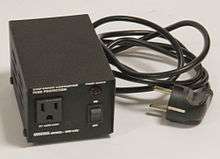
- There are two different types of transformers: "step-up" and "step-down". Step-up transformers allow you to plug a higher-voltage device into a lower-voltage power socket (such as using a UK device in the US). Step-down transformers allow you to plug a lower-voltage device into a higher-voltage socket (such as using a US device in the UK). Some transformers offer both. Take care to use the right type: if you plugged a 110-to-220 V step-up transformer into a 220 V socket, you would get 440 V and a fried device.
- You must also make sure that the power rating (wattage) of your transformer is at least 10% greater than that of the device; otherwise, the transformer can overheat and even catch fire. Before buying a transformer, look for the "input" figure: usually on the device's plug or in the manual. Some don't display wattage, but you can work it out simply by multiplying the voltage (V) and the current (amps (A); if it is milliamps (mA), divide by 1,000). The resulting figure is the same as the wattage.
- Transformers can be used with both electronic devices (such as those with chips and circuits) or electrical appliances (such as those with heating elements and motors). They can usually operate for a much longer time than converters.
Converters
These lighter-weight, less expensive devices can handle large wattage loads of up to 1600 watts but only step-down voltage, not raise it. They are suitable for those in 110–120 V countries travelling to where the voltage is 220–240 V. Converters are designed to operate for only an hour or two at a time, not continuously. As stated above, they cannot be used with electronic devices: devices that use chips or circuits, such as a computers, printers, VCRs, or even battery chargers.
Nowadays, many electronic devices actually come with a converter which plugs into the power mains and converts the current to DC. However, if this won't accept a foreign voltage (check the plug) do not place a second converter behind it. You must use a heavier transformer instead. Fortunately, in the past few years, more and more devices come with a universal voltage AC/DC converter already included, and the most you would need is a plug adapter.
Frequency (Hz)
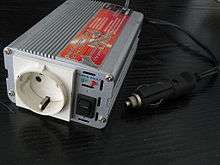
In alternating current (AC), the voltage cycles from positive to negative and back in a sine waveform. How many times the voltage cycles per second is the AC frequency and is expressed in hertz (Hz). The opposite is direct current (DC), in which the voltage stays constant over time. AC is used for mains electricity since the voltage can easily be increased or decreased using a transformer. This current is converted to DC to charge a battery or to operate electronic devices.
Frequency is generally not a problem — most travel items will work on either 50 or 60 Hz. If all the electrical appliance does is produce heat or light (except fluorescent lighting), then the frequency is unlikely to matter. Japan is a special case: East Japan (e.g. Tokyo) uses 50 Hz and west Japan (e.g. Osaka) uses 60 Hz. Equipment made for the Japanese market may have a switch to select 50 Hz or 60 Hz.
Frequency is most likely to affect non-quartz clocks and devices with motors. They may run faster or slower than they should, and may be damaged in the long run as a result. Again, though, some motorised devices may function correctly on either 50 or 60 Hz — especially if they also operate on batteries. Just look on the label or plug.
If your appliance runs on a rechargeable battery, such as laptops and mobile phones, it should be equally apt at operating on 50 or 60 Hz. This is because the charger converts the AC mains electricity to DC to supply the appliance. However, things get more complicated with larger appliances that convert AC to DC. Large converters produce harmonics, which can interfere with other electrical appliances. To reduce harmonics, filters have to be used, and these filters are usually designed for one frequency only. If you also need to change the voltage (because the voltage of your device is different from the power mains voltage), you cannot use a switching-type converter. You must use the heavier iron-core transformer. If in doubt, consult a reputable electrical goods dealer.
If your device won't operate with a different frequency (powerful motors and non-quartz clocks), there are relatively few options. Unlike voltage, frequency cannot be converted by transformers. The only common methods of changing line frequency are to convert to mechanical power and back (with a bulky motor-generator set) or convert electronically to DC and back (using an inverter).
A 12 V DC to AC inverter will often be marketed for vehicle use. Many inexpensive mass-market versions output a "sawtooth" wave instead of a sine wave; this may pose issues for clocks keeping time from the frequency and some electronic devices. (A sine-wave inverter may be special-order at a premium price.) Power is also severely limited; for example, 12 V times a seemingly-hefty 15 A yields 180 W (or less after losses are included) - which is just an amp and a half at 120 V or a mere 0.75 amps at 240 volts.
Another option is using an "uninterruptible power supply" (UPS), often used for computer equipment. Prices and sizes vary, and if power mains voltage doesn't match, you'll need a heavy iron-core transformer of the same wattage. Be sure to check for "pure sine wave" output, if needed. A UPS may have its power specification in volt-amps (VA). This matches the wattage, but also implies a maximum current limit when the voltage is divided out.
Appliances
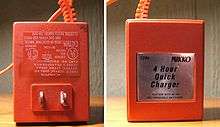
If you are buying new appliances, get in the habit of checking the voltage. A dual-voltage hair straightener will cost you no more than a single voltage one, and save considerable hassle when travelling.
Laptop computers
Virtually all laptop computers (including those with internal power supplies) will handle well a range of 100 to 240 volts and a frequency of 50 to 60 Hz. In other words, you won't need a converter/transformer; most power supplies have supported ranges printed directly on them so have a look. You will still need to check that you have the plug that matches the outlet for the country you are going to, to see if you need to buy an adaptor.
Laptop computer power supplies are generally very good at accepting a poor or varying supply. Many manufacturers use the same type of supply, so getting spares is not too hard. The type used by HP/Compaq is very common. It is very easy and cheap to get a spare supply from sites such as Ebay. However, make sure it is a genuine manufacturer replacement and not a cheap copy. With a spare, you can take a risk with an unknown supply. Of course, do not take any risks if your laptop is one of the few with an internal supply.
If you are taking a laptop, you can use it to charge other items using the USB ports. Be sure to bring the correct cables – a USB device cable may terminate in any of micro-USB, USB Type-C, Apple 30-pin or Apple Lightning connectors depending on your mobile phone. Digital cameras often charge from USB with a non-standard cable as manufacturers use proprietary connectors.
Many tablet computers can charge with 5V from a standard microUSB connector, but there are exceptions (Acer makes a few models which use standard-looking USB connectors but only charge from a proprietary charger at a non-standard voltage).
Radios
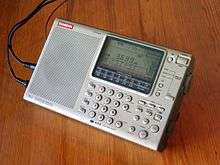
Radios tend to be interchangeable from country to country, as long as the power issues are settled and the radio handles the right frequencies. The exact FM range being used in a few countries is different, so you may not be able to access all stations. In the Americas, only odd channels (88.1, 88.3, 100.1 etc.) are used. A radio intended exclusively for the US market will not work well overseas. Japan, in particular, has an FM band from 76 MHz to 90 MHz rather than the more common 87.5 MHz to 108 MHz. The countries of the former Soviet Union have also used a similar band. For the medium wave band, channel spacings (the difference between each valid frequency) can be 9 kHz (Europe, Asia, Africa, and Oceania) or 10 kHz (Americas). Radios with digital display and buttons for tuning may have a switch or setting to choose which channel spacing is used. Without this, they will not work correctly outside their intended market. Old-fashioned analog-dial tuners don't have this limitation.
If you need a new radio for international travel, consider one that includes the shortwave band (SW). This way, you can receive news and information from all over the world (BBC, Deutsche Welle, Voice of America, Radio Australia, etc.) Shortwave broadcasts are at a higher frequency than the medium wave (MW, designated AM on many radios) band and travel a lot further, especially after dark, but are noisy and prone to signal fading. In the past decade, the size and price of AM/SW/FM radios have come down considerably and they are much easier to use. Some shortwave radios provide an adjustable beat frequency oscillator (BFO); while not required for standard broadcast reception, this allows reception of SSB (single side band) amateur radio signals. Many broadcasters have cut back their shortwave programming in recent years (BBC, for example, ended shortwave broadcasts to Europe in 2008) so verify that shortwave is still broadcast to the region you are visiting in the language(s) you want to hear.
Shortwave radio may be used as an accurate time source by tuning to WWV (2.5, 5, 10 and 15 MHz) or similar signals from various nations worldwide. Coastal VHF FM radio provides weather forecasts continuously or at set times on marine VHF frequencies (some of the information may be useful for non-mariners). There may also be other specific weather frequencies well outside the standard FM broadcast band; in North America, some purpose-built "weather radios" sound an alarm if tornadoes or other extreme weather pose an immediate danger.
Digital radio
Digital radio is in use in some countries, mainly in highly developed and industrialized areas. The most common systems are:
- DAB, the main European standard
- DAB+, an update to the DAB standard, used in some European countries and Australia
- DRM, used in India and for long distance radio broadcasting
- Several other systems have limited usage, including HD Radio, the standard used in North America, T-DMB, a variant of the DAB standard used in South Korea, and ISDB-tsb, used in Japan.
The success of digital radio varies from country to country but it has generally been the most widely adopted in Europe. In Norway, adoption of DAB and DAB+ radio is now high enough that the country shut off its FM radio transmitters in 2017, several other European countries, such as the United Kingdom, the Netherlands and Germany, also have extensive DAB radio offerings, while other countries, including Spain and Sweden, have begun rolling out digital radio services. Elsewhere countries such as the United States and Australia maintain underdeveloped digital radio services and remain highly dependent on analog radio, and even highly developed countries such as Finland and Portugal have no digital radio service at all. Canada tested DAB in a handful of cities, only to shut it down in 2010, and is now beginning trials of HD Radio broadcasts. In general, analog radios will be adequate for most travelers, although those planning to travel to Europe may want to look into buying a radio with also DAB and DAB+ capabilities.
Two-way radio
Radio transmitters are subject to varying levels of government regulation and licensing in each country as transmitting too powerfully or on the wrong frequencies will interfere with other stations. That Australian 477 MHz UHF CB rig which required no license in its home country might not be welcomed in North America as it obliterates channel 15 on all the neighbours' HDTV's.
Two-way radio, or walkie-talkie, standards for the general public include CB radio, UHF CB, PMR446, FRS, GMRS and MURS. Some of these work in only one or a few countries, other in several, but the allowed frequencies often differ, so that some of the channels on the radio are illegal and some of the legal frequencies unavailable. Do your research.
Most channels of Marine VHF are available worldwide with varying licensing requirements, but usage restrictions on individual channels vary. Small craft that only needed an operator's licence at home may need an ITU callsign on marine frequencies abroad. Licences for ship crew are more or less globally accepted, but licences for recreational or coastal traffic may be restricted to domestic waters. Use of marine radios on land is restricted to facilities such as harbour masters, weather stations, marinas or canal, lift and swing bridge operators, which operate on one assigned frequency only. Calling channels also vary, as some countries reserve VHF 16 for distress calls only. Misuse of a locally-reserved channel will not be received gratefully.
Some countries will recognise foreign amateur radio licences if the stations are properly identified on-air and operated with local frequencies and power levels; others will not. Some may issue a local licence to a foreign operator. There's an entire hobby in temporarily placing portable radioamateur stations with huge antennas on obscure uninhabited islands as "DXpeditions" so that hams overseas can get one more hard-to-find country into the log books, but a few countries (such as 'P5' North Korea) are pretty much impossibilities as they license no one.
Wireless networks such as 2450 MHz Wi-Fi and Bluetooth are likely to exist in some form, but a few countries don't allow all channels to be used. There's usually a setting on the base station (or Wi-Fi router) to specify which country's frequencies may be used. It's not necessary to configure this on every computer joining an existing wireless network.
Cellular telephones which are on the wrong frequencies for a country or region won't find the base station and simply won't use the network. They may still be usable as offline tools or as VoIP phones and Internet browsers where Wi-Fi connections are available.
Recording and playback devices
Unlike video playback (which is a mess of incompatible standards and annoying regional encoding schemes), recorded audio tends to be reasonably well standardised internationally. The usual cautions about equipment compatibility with regional line voltage and frequency still apply; a turntable powered by a synchronous AC motor will play your vinyl LP's on the wrong speed as a transformer only changes voltage, not frequency. Battery-powered or crystal-controlled devices (such as MP3 players) are not affected by line frequency, even if they're running from an AC adapter (just get the voltage right!).
Mobile phones and digital cameras
- See also: mobile telephones
Most recent-model mobile handsets have standardised on USB as a +5 volt charging source. Chargers are available for both 110 V and 240 V AC, there are also adapters for the 12 V DC system in cars. Dual voltage chargers support both mains systems (though some may still need an adaptor plug).
Older cellphones used a wide-array of non-standard connectors and proprietary chargers. 21st century handsets (and smartphones) are increasingly standardising to USB chargers but cables vary due to multiple connector types. Micro-USB (or USB Type-C on an increasing number of 2010s devices) are commonly used with Android devices. Apple's iPhones need a cable with that manufacturer's licensed proprietary connectors.
For mobile phones there is the additional problem of getting a connection. Smartphones can usually obtain a Wi-Fi connection abroad (which may suffice to enable Internet telephony) but ability to connect to the destination country's mobile network varies; handsets may be on the wrong frequency, use incompatible standards or be locked to a single provider.
Digital cameras do not need a network connection, but do require a compatible charger. Most will charge from USB but many require cables with proprietary connectors. Some digital cameras still take AA batteries, and they may be a better option if you plan on traveling without access to mains power for extended periods of time.
Equipment using standard batteries
Battery sizes and voltages tend to be standard from place to place, and equipment that uses off-the-shelf batteries tends to be interchangeable. It may be difficult to get good quality batteries in some countries, especially alkaline batteries which are needed by most electronic equipment. If a cheaper battery is used, make sure to remove it as soon as it is exhausted and when the equipment will not be used for a while, due to the risk of leakage.
Dual voltage battery chargers for NiCad and NiMH generally cost no more than single voltage ones, but you need to look for this feature before you buy. If an existing single-voltage charger uses a 12 volt DC adapter, find a quality dual-voltage adapter (110 V to 240 V) at 12 Volts DC with its DC current rating (in milliAmps) equal or higher, and the same size plug on the charger end. (This is not possible if the charger plugs directly into the power mains without any cord.)
Be cautious
Large appliance power mains

In most countries, electrical power is distributed to industrial/commercial buildings using a three phase system. An industrial three-phase outlet has three different live/phase wires and optionally a single neutral wire. These use non-standard or physically larger connectors (compared to the ordinary domestic plug and socket for a country), typically with higher maximum current and four or more pins to accommodate the three phases plus a neutral or ground.
Normal domestic outlets are invariably single phase. They will receive just one of these phase wires and a neutral wire. Three-phase outlets may be available on the factory floor, or be employed to power large commercial or industrial equipment. Some private homes may have three-phase power available for power-hungry appliances such as kitchen ranges, water heaters and air conditioners (which usually are hard wired or use custom connectors). You may find the industrial type outlets at the distribution board or somewhere where large machines might be used, such as in a workshop. You won't find these outlets in normal rooms.
Another variant in nominally 120 V regions is a centre-tapped 240 V 60 Hz system connected to a large load such as a kitchen range or a full-size clothes dryer. The 240 V plug has both blades turned sideways or is a physically larger plug with four pins (two live wires, a neutral and a protective ground) designed to handle greater current.
These non-standard connectors carry typically higher voltages (a European industrial three-phase outlet with 230 V line-to-neutral has 400 V line-to-line; Canada and USA make some industrial use of 600 V or 480 V line-to-line, respectively). They are appropriate for running large machines with motors, large air conditioners, industrial/commercial ovens and other power hungry appliances.
In countries using the "Australian" plug, you may occasionally come across a socket with a larger than normal vertical earth pin. This is a 15 A rated socket; the standard socket is 10 A rated. Since British and European outlets are rated at 13 A and 16 A respectively, it is generally fine to use for smaller appliances.
Regardless of voltage or how many phases are in use, the frequency (50 Hz or 60 Hz) of the local supply remains unchanged.
In countries with a poor distribution network, it is not unknown for single phase sockets to be connected across 2 phases to boost the voltage. This is dangerous and can damage electronic equipment.
As a general rule, do not attempt to connect your personal electrical items directly to an unknown three-phase system.
If you see a non-standard (for its country) or oversized connector, the voltage or current delivered may also be non-standard (for instance, 240 V 60 Hz feeding a large appliance in a nominally 120 V region, or a circuit breaker sized to allow enough current to pass to power a small house or cottage). Don't just connect and hope for the best.
Generators
In many countries without fully developed electrical power distribution systems, the use of generators is common. Generator supplies can be very good; however, in many places they are bad and can cause damage to sensitive equipment connected. The voltage, frequency, and waveform shape (it should be a smooth sine-wave) can vary. In some places, people modify generators to run faster. This gives more voltage and power but increases the frequency too. The part of a generator that keeps it running at a constant speed is called the governor. If this is tampered with, the output voltage could rise sufficiently to cause damage. The best advice is not to connect valuable equipment to the supply, or at the very least disconnect it as soon as you're finished.
If you are unsure about the quality of the generator in use, there are a few simple rules. If it runs from petrol/gasoline, it is bad: anyone serious about using generator power uses a diesel oil powered system. A good quality generator will have a low engine speed. 1,500 RPM for 50 Hz or 1,800 RPM for 60 Hz. If the engine speed is 3,000 RPM or more, it is not a good machine. It is entirely possible to make a good 12,000 RPM petrol generator; it is just not economical in most cases, and so they are too rare in general use to matter.
Lamps
Lamps and their light bulbs are very sensitive to voltage. If you shift between voltage systems, you will need to change the light bulbs to match the voltage, unless the lamp is designed to operate on both systems, say through a low voltage adaptor. If you buy a lamp abroad, you may need to have an electrician completely rewire a lamp when you get home to comply with your country's electrical safety standards. This may not be a problem for a one-off special item, but if you are going into the importing business it could be a show stopper.
Also watch out for the light bulb connection. In 100–127V systems this is often a screw connector while in 220–240 V systems it is often a bayonet connector. These connectors also come in at least two different sizes. Be sure you can obtain light bulbs of the right voltage, size, and connector shape in the country you intend to use the lamp, and at a reasonable price, or the lamp may become little more than junk when the bulb fails.
Note that fluorescent and LED lighting contains electronics and must use a heavy iron-core transformer to convert voltage. Converters are not acceptable.
Some fluorescent units might be sensitive to changes in frequency (50 or 60 Hz) if it's not the same as what is specified. Most affected are fixtures with a large coil or inductor as "ballast" to limit the current into the bulb, as the impedance of these coils is directly proportional to frequency. Electronic ballasts usually convert the AC line directly to DC (and then to a higher-frequency AC), causing line frequency to be ignored.
Electric motors
The electric motors in things like refrigerators, vacuum cleaners, washing machines and other whiteware are often sensitive to frequency, the same goes for older hairdryers and electric shavers. Even if you use a step-up or step-down transformer, the different supply frequencies mean that motors will run at the wrong speed and quickly burn out. The larger and more powerful the motor is, the more this is true. Don't, for example, bring a vacuum cleaner from the US to Europe (or vice versa). It's almost guaranteed to fail—even if you have a voltage converter.
Electric shavers
Hotels often provide a special electrical outlet specifically for electric shavers. They allow any voltage shaver to be plugged into them and be used safely in front of the bathroom mirror. They may also accept your cellphone adaptor or similar low power battery charging unit. Many electric shavers sold today are dual voltage 50/60 Hz and some will even recharge the battery at 12V DC (such as in an automobile). Check the label and instructions for compatibility.
Hairdryers
Hairdryers are a particular risk; if you accidentally plug your 100–120 V hairdryer into a 240 V outlet. you may find it catching fire in your hands! Newer models should have a thermal switch, though. Allow 15–20 min. for it to cool down, then use a voltage converter (if the dryer is 50 Hz compatible). Similarly, a 220–240 V hairdryer in a 120 V outlet may run slowly and not heat up enough. Most good hotels and motels will be able to supply a hair dryer, and it may even be a room fitting. However, it may be worthwhile buying or borrowing a hairdryer suited for the electrical system of countries you'll be traveling in.
Many new hairdryers sold in 100-120 V countries are dual voltage with settings for 100–120 V and 220–240 V. Even though it's motorized, it will work on either 50 or 60 Hz. Don't forget to lockout the high setting with a flat screwdriver or something similar. At 220–240 V, the low setting becomes as powerful as the high setting was at home (with 'low' unavailable).
Clocks
An electric clock of any sort is sensitive to voltage. If the voltage is doubled or halved, it will not function and may burn out. Furthermore, the electric frequency (50 or 60 Hz) is used in cheap clocks (such as many clock-radio style clocks) to keep the time. Thus, if a clock made for North America were used in Europe – even with a voltage adapter – it would lose 10 min/h! Obviously, not a great idea if you have a train to catch. The mains frequency is influenced by mismatched electricity supply and demand (a dip in frequency suggests a generator going offline or an increase in demand, and vice versa), and therefore will drift by up to 0.25 Hz either side of the nominal frequency. This may cause mains-powered clocks to become inaccurate over time. During 2017/2018, small but systematic deviations from 50 Hz in the European grid caused such clocks to go wrong by several minutes.
On the other hand, if the clock has a quartz crystal, this is used for the timekeeping, and it operates independently of the line frequency. Inexpensive, battery-operated, digital LCD travel clocks (with a push button back light) are also available. These are recommended for destinations with frequent blackouts. Often, a battery-powered alarm clock will be built into some other device, such as a pocket pager or mobile telephone; this clock usually still works even if the original paging or telephone service was unsubscribed years ago.
Video equipment


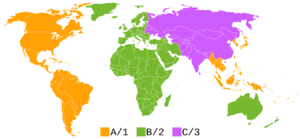
Before purchasing any video equipment, read the manual and warranty carefully. Televisions, many radios, video and DVD players, as well as videotapes, are often specific to the broadcast system used in the country that they are sold in, usually associated with the frequency of the country's electric current. For example, North America is 60 Hz and its television is 30 frames per second, while Europe is 50 Hz and its television is 25 frames per second. Unless you have an internationally compatible device, you may find your expensive looking system is little more than worthless junk in another country because it won't work with your country's broadcast system. Your warranty is probably only valid in the country of purchase, and you may need to return the goods to the place you purchased them from.
There are three main analog television broadcast systems:
- PAL, the closest to a worldwide standard, is used in the UK, Germany, much of western Europe as well as Australia and New Zealand.
- NTSC is used mostly in the Americas and some East Asian countries (notably Japan, South Korea, and Taiwan).
- SECAM is originally from France and was adopted by much of Eastern Europe and the Middle East.
There are various incompatibilities even within these supposed standards. For instance, Brazil uses a hybrid PAL/NTSC standard called "PAL-M". The system operates at the same resolution as NTSC (so DVDs and video tape are interchangeable with their NTSC counterparts, unless restricted by region coding), but the format of the over-the-air signal differs enough that PAL-M players and TV sets are useless outside the country unless they have a separate NTSC setting.
Likewise, there are multiple incompatible over-the-air digital television systems:
- DVB-T, the closest to a worldwide standard, originated in the European Union. Most locations which were PAL or SECAM in the analog era use this system.
- ATSC, the North American standard, is used in South Korea (but not Japan).
- ISDB, Japan's own incompatible standard, has been exported to some South American countries but is otherwise rarely used.
- There's also a DTMB which is standard in mainland China; there has been no widespread international adoption of this system.
Again, there are incompatibilities even within each standard; for instance, some countries (such as Brazil) use MPEG4 while others use MPEG2.
The likely result of bringing a TV to another country with an incompatible system varies. If the voltage is wrong, the equipment will not work at all or will be damaged. This can be remedied with a line-voltage transformer; if the equipment is "120/240 V 50/60 Hz" a plug adapter or replacement power cord may suffice.
Even if the voltage is correct, the TV will not be able to receive programming over-the-air if the broadcast frequency or the signal format is wrong. Using the TV solely as a video monitor (instead of relying on the TV's built-in over-the-air tuner) will give mixed results:
- A signal which is merely on the wrong frequency will need to be tuned with a converter box; the aerial (or antenna) will need to be replaced for the correct bands. An over-the-air signal in the wrong format likely won't work if fed through an external tuner to the standard-definition analog "video in" jacks on a TV.
- Most standard-definition analog baseband "video in" connections (such as "composite video" or "S-Video") are tied to the local video system. NTSC won't mix with PAL/SECAM at all (as the number of lines and frame rate don't match). Mixing PAL with SECAM is likely to produce a monochrome image.
- Analog HDTV signals (such as VGA, "component video" or RGB) fare somewhat better as there are separate inputs for each color and frame rates are more flexible.
- Computers (and their video displays) are standardized relatively well. Digital formats like DVI, HDMI, and DisplayPort are likely to be compatible internationally. Don't be surprised if your foreign TV works perfectly well as a computer video monitor, but is non-functional for watching videotapes in the local format or tuning stations over-the-air with the built-in tuners.
Don't forget about cable TV frequencies; they may not be the same, even if everything else is. Furthermore, many countries have switched or are switching to digital over-the-air broadcasting (see dates by country on Wikipedia).
The final problem with transporting TVs is that many European countries, notoriously the UK, require a television licence to watch any live TV (over-the-air, cable, satellite, and even live-streams on the internet); the fees are used to fund public broadcasting such as the BBC. This even includes USB TV tuners for computers and laptops if they're capable of DVB reception. Licenses are typically in the range of €100-300/year, and fines for dodging the license can be hefty.
Bringing prerecorded tapes or discs with their player and the matching display/monitor to another country as a package will likely work if the line voltage is correct.
An attempt to mix and match local and imported pieces in the same system potentially has a few pitfalls:
- Technically, there is no such thing as an NTSC or PAL DVD disc, as all color information is the same for both. When discs are labelled as such, what they're referring to is the picture size and frame rate (i.e. number of frames per second) that are used in most (but not all) countries that have TV broadcasts on this same system. Many NTSC players cannot play PAL DVDs, unless that's a specific feature included (many Philips and JVC models include this). PAL DVD players are generally much better at playing NTSC, but it's not a certainty. If all else fails, a computer DVD-ROM can play any DVD movie, though there's a limit on how many times you can change the region code. Unlike analog television sets, computer monitors can automatically handle both 25 (PAL and SECAM) and 30 (NTSC) frames per second, as well as various picture sizes. This also applies to LCD and plasma "flat panel" television sets, but don't expect their tuner to be compatible outside the country in which they were sold.
- There is no difference between PAL and SECAM for unconverted digital video including DVDs. However, any analog output to a television set would be in the native format of the country of location.
- DVD and Blu-Ray, infuriatingly, have completely artificial limitations introduced in the form of region coding, which attempts to limit the region where the discs can be used, as a technique to keep the various regions as separate markets. For example, a Region 1 player for North America will not play a Region 3 DVD for Hong Kong. The workarounds are to obtain either a region-free player which ignores the code, purchase multi-region discs (Regions 1 and 3 in this case), or better yet, region-free discs (Region 0 for DVDs), which can be played on any device.
Video cameras can usually be charged with both electrical systems so you can record during travels and view it back home. Digital cameras and video cameras can usually output to PAL, NTSC, and SECAM, so you can view your recording while travelling. Output from video cameras is typically composite (yellow RCA jack); you'll likely need an adapter from RCA to either SCART or S-Video to use a European television set.
If you have something on VHS video tape, it's best to convert to DVD before travelling. (Conversions between PAL and NTSC can be done before burning.) Use a video capture card for recording the VHS into a digital file on your computer. Then with DVD-making software, burn the file to a blank DVD.
If required, converting DVDs from one format to another (e.g. PAL to NTSC), can be done on a computer with a fast CPU, or you can get it done professionally. Allow plenty of time, as this can take many hours. Regular blank discs work fine for making copies of a foreign format, as it's all just a bunch of ones and zeros and no different than copying anything else. Copies can be made quickly, while conversions cannot.
Stay safe
|
The electrical engineer's maxim The smoke that escapes from a device or a component is its spirit without which it cannot work. In other words: if smoke rises from the device, then it's destroyed. |
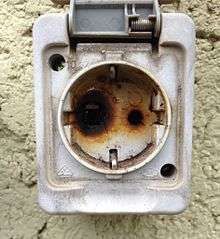
The first time you use electrical equipment on a voltage system you haven't used before, watch for excessive heat, strange smells, and smoke. This is especially true for those residing in countries with 120 V (USA, Canada, Japan, etc.) visiting places with the higher voltage. Smoke is a sure sign your equipment cannot cope with the voltage system.
If your electrical equipment gets very hot, smells of burning (there is a distinct smell of electrically fried circuit boards) or starts to smoke, turn it off at the wall, fuse box or the main switch immediately, then carefully unplug the equipment. Do not disconnect or unplug by just grabbing the smoking device, its plug or cord, and then unplugging it, as these parts are probably very hot, and the insulation could be melted or unsafe, which could result in electrocution. Rubber gloves insulate you from current, but not from heat.
You may find your expensive equipment has been fried and needs to be replaced because the wrong voltage was used. However, if the equipment only got hot and did not smoke or produce strange burning smells you may be lucky. Some older devices have fuses that you may be able to replace. New devices, such as gaming consoles, will trip a circuit breaker. Disconnect them from all power and leave them for 60 minutes or so, and the circuit breaker will normally reset. That said, do not rely on fuses to protect your equipment. If a fuse does blow, you should have things checked by an electrician before using the suspect equipment again (unless you're sure that you accidentally plugged in a 120 V device into 240 V power mains).
In countries with frequent blackouts, it's not at all uncommon for a visitor to plug something in and have the power go out coincidentally. Always check the neighborhood first, before blaming the appliance or looking at the fuse/circuit breaker.
Electric shocks
Electric shocks are caused by electricity passing through a human body to earth rather than along the neutral return wire. It should go without saying that electric shocks can kill; at mains voltage, only a very small current (0.03 amps) is needed to interfere with the heart's electrical system and cause the person to enter cardiac arrest.
Damaged or frayed power cords are ripe for causing electric shocks, especially if they come into contact with water. If a power cord becomes frayed or damaged, stop using the appliance immediately and get the cord repaired or replaced.
A residual-current device (RCD) (also known as a ground fault circuit interrupter (GFCI) in the US and Canada) can help prevent electric shocks. It measures the difference in current between the live and neutral wires and if the difference is excessive (suggesting a leakage to earth), the RCD trips off the power. Most new and remodelled homes in developed countries are now required to have RCDs on the distribution board. If you are using an appliance outdoors or in a wet area (e.g. a bathroom), you can buy plug-in RCDs for individual appliances. Some devices such as hair dryers commonly have them already built into the electrical plug.
Power spikes and surges
Power spikes are where the voltage supplied temporarily surges to dangerous levels, with potentially catastrophic consequences. In developed countries, the main source of spikes is weather events such as thunderstorms. in developing countries, they're most often associated with power outages since when the power comes back on, it rarely does so smoothly.
The cheapest method of protection is thus simply to disconnect electronic devices as soon as the power goes out and wait a few minutes after the power comes back on until plugging them back in.
Surge protectors are devices designed specially to protect against spikes and surges, and some are available in portable travel-sized versions. Some surge protectors can also be fitted to a telephone line to protect your phone or laptop modem. The most common variety use a metal oxide varistor (MOV), which shorts to ground if a given voltage is exceeded. These are easily destroyed by larger spikes, and better models will have a light indicating when the MOV has broken down, but you still need to keep an eye on them as the device will still continue to give power even if the protection is gone. There are also surge protectors with fuses, which are fail-safe (a blown fuse will stop power) and replaceable, but there is still a risk of a short, sharp spike which can pass through and damage your device before the fuse blows.
Equipment that switches on and off and has a heavy power draw can also cause surges; fridges and air conditioners are common examples. Even a photocopier drawing different amounts of power as it cycles through pages may produce quite a bit of noise on electrical lines. This is more of a problem for older equipment and buildings than new ones, and more in developing countries than elsewhere.
Voltage drops
In some regions, you may experience electricity voltage drops. This is where the actual voltage less than 90% than the nominal supply voltage (e.g. below 207 V where the nominal voltage is 230 V). In poor regions, voltage drops 50% of the nominal supply voltage is not unknown. This happens especially if you're at "the end of the line" (far from the source or transformer) and is caused by the resistance of the electric lines themselves. Some appliances, such as light bulbs and heating equipment just keep working under a lower voltage, although a 20% voltage drop will cause a 36% power drop. Most electronic devices also keep working, but voltage drops are critical for fluorescent lamps, refrigerators, and air conditioners which may stop working altogether (usually without being damaged: when the voltage returns to normal, they will start working again).
Voltage drops can be solved with a special device called a voltage stabiliser or AVR (automatic voltage regulator). A stabiliser will raise the voltage again to its normal level. The principle is the same as for switching converters, except that stabilisers will produce a stable output, even with an unstable input. Stabilisers come in different power ranges, but they're all large, bulky and not practical to carry around. Be aware that some appliances, such as refrigerators, briefly consume two or three times more power at start up; the stabiliser should be able to provide this power. Voltage stabilisers can introduce surges if there is a power outage. The cheaper and most common relay type can also damage electronic equipment.
Blackouts
Blackouts may occur anywhere in the world, though they are more likely in places with lower standard of infrastructure (usually poor countries). Blackouts are not unheard of in developed countries, though there they are mostly caused by extreme weather events or third-party damage (car vs pole, careless digger, etc.). Rural areas are more prone to power outages due to a larger proportion of overhead lines on poles, exposed to the elements, and fewer opportunities to re-route power around a faulty line. Even in first world countries, huge power outages are possible but rare (an example is the 2003 power outage in North America).
A rolling blackout is where different areas are switched off and on in turn as a way of reducing demand. These types of power outages may be common in developing countries. In developed countries, rolling blackouts occur as a last resort where there is insufficient generation, such as after a major power station failure.
Check
.jpg)
As stated above, while things like cell phone chargers and electrical shavers (that often get to travel with their owners) nowadays are designed to handle different voltages and frequencies, you have to be much more careful if you're bringing appliances overseas. If you are taking equipment with you that isn't intended for travel use, consider taking a multimeter with you that can handle several hundred volts AC and learn how to use it. With a multimeter you can easily check the voltage in the outlet and don't need to risk the life of your equipment. The ones with a digital display are easier to read and a few are as compact as a small pocket calculator.